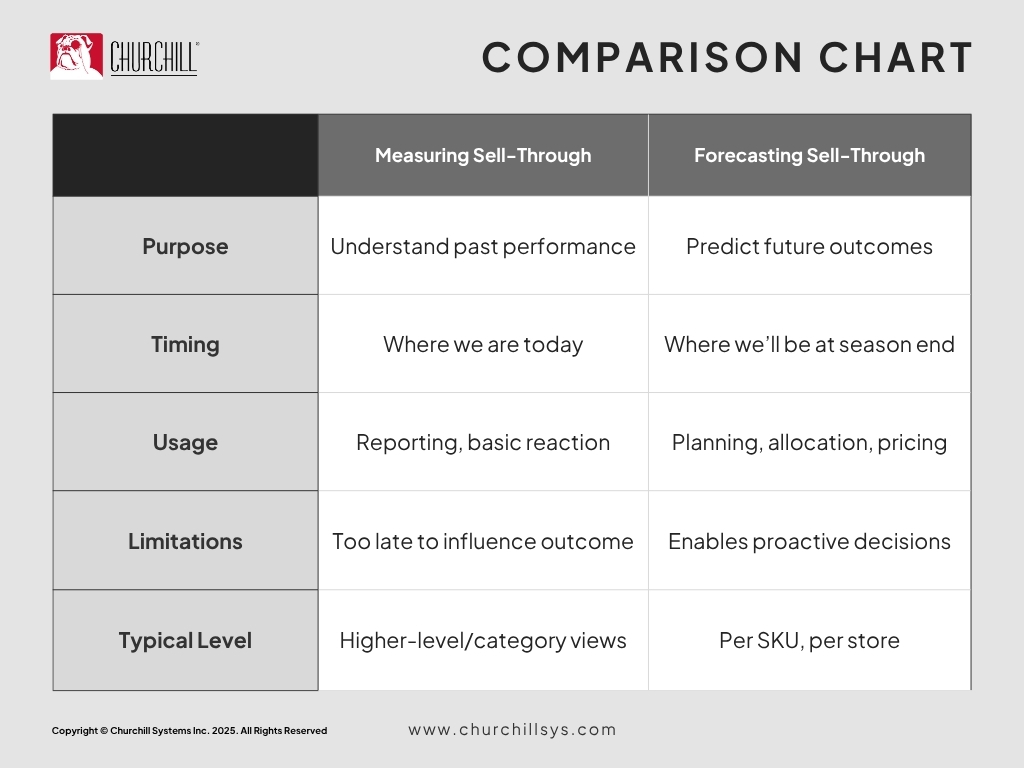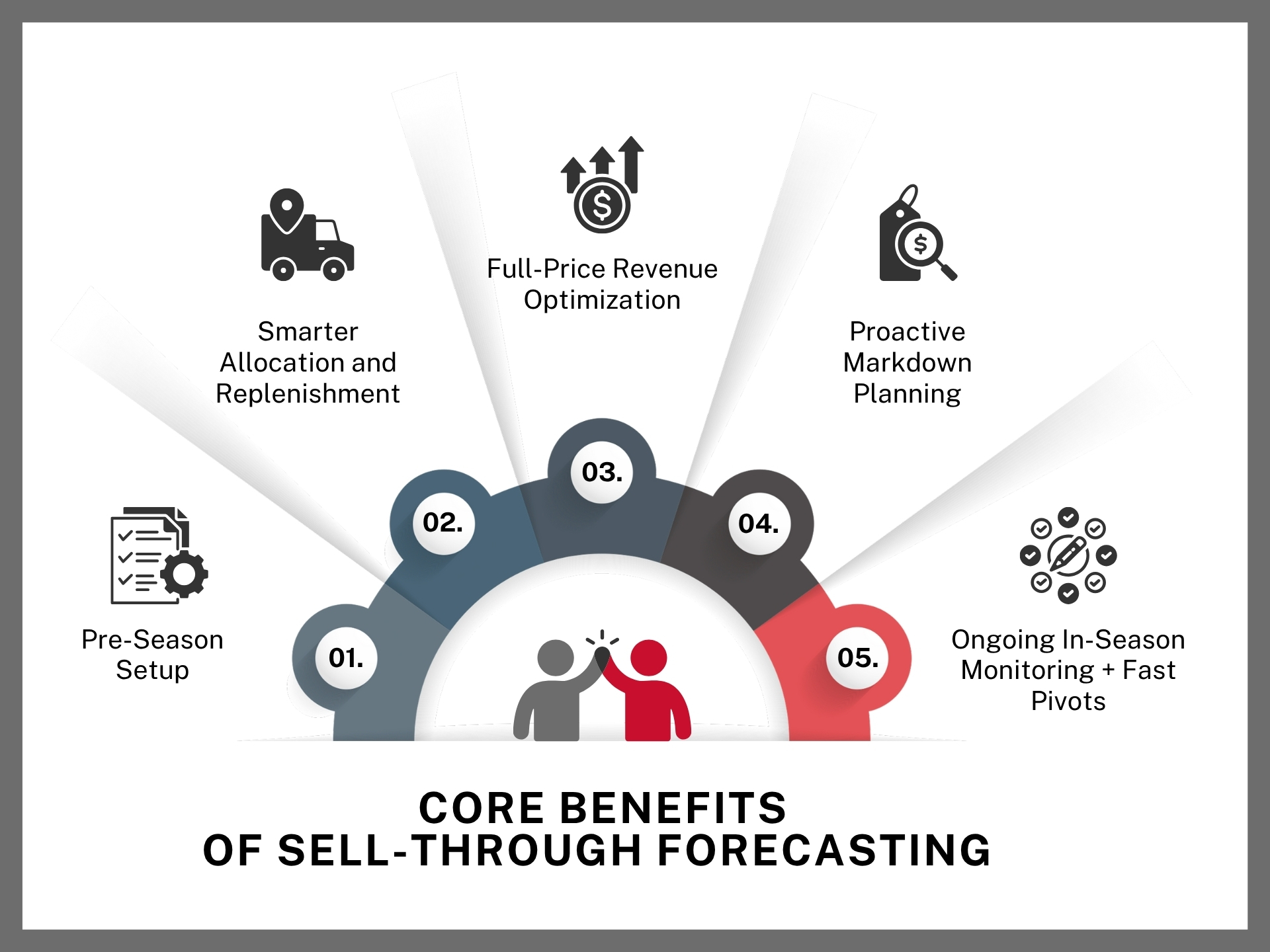Share on social
Highlights
What Is Sell-Through Forecasting and Why Is It Important in Retail?
Most retailers track Sell-Through — but few forecast it.
Sell-Through is a performance metric. It’s calculated as the percentage of inventory sold over a specific time — often tracked daily, weekly, or monthly.
For example: If you ordered 100 units of a product and sold 60, your sell-through rate is 60%.
Simple enough.
But here’s the problem: That number tells you where you are. It doesn’t tell you where you’re going.
Measuring Sell-Through is a retrospective. It’s useful for understanding how a product has performed up to this point. Retailers use it to report performance against their seasonal plan or to identify underperforming items that may need discounting. But by the time you’re reacting to Sell-Through metrics, much of your flexibility is already gone.
Forecasting Sell-Through, on the other hand, is prospective. It answers a different question: “Based on historic and/or current trends, how much of this product are we likely to sell by the end of the season — and where?”
Done right, it becomes a decision-making engine that influences how you allocate, replenish, price, and promote products — in time to make a real difference.

The Problem with Traditional Sell-Through Analysis
Retailers today operate under immense pressure — balancing margins, inventory risks, and customer demand across thousands of SKUs and locations. And when Sell-Through is treated as a static metric, problems multiply:
- Reactive Decisions: If you’re acting only on current sales, you’re too late. That delay results in overstock, stockouts, and missed margin opportunities.
- Operational Overload: Calculating projected Sell-Through by store and SKU — manually or in spreadsheets — is impossible at scale.
- Timing Trouble: Whether your season is 6 weeks or 26 weeks long, reacting late means you’ve already lost opportunities.
Core Benefits of Sell-Through Forecasting

Pre-Season Setup: Set Smarter Targets Before the First Sale
Effective forecasting starts before a single unit is sold. By projecting Sell-Through in advance, retailers can establish realistic, data-driven targets for each SKU at each store — aligning inventory levels with anticipated demand from day one. This proactive planning reduces the risk of overstocking slow movers or underestimating high performers.
Smarter Allocation and Replenishment: Align Supply with Demand
Traditional Allocation methods often rely too heavily on historical sales, which can penalize high-performing stores that sell out early. When inventory runs out, sales data stops — but that doesn’t mean demand does. Sell-Through forecasting addresses this by focusing on expected demand which factors in lost sales, not just recorded transactions. It allows retailers to allocate and replenish inventory based on true selling potential — ensuring every store gets what it needs, not just what it sold last time.
Full-Price Revenue Optimization: Protect Margin with Targeted Action
When Sell-Through is forecasted at a granular level — store by store, SKU by SKU — retailers gain the ability to act with precision. Instead of blanket discounts, they can identify exactly where intervention is needed and preserve full-price revenue in markets that are performing well.
Proactive Markdown Planning
Markdowns are often used as a last resort — reactive and margin-eroding. Sell-Through forecasting enables a proactive approach, flagging early signals of underperformance and guiding pricing adjustments before inventory becomes a liability. Markdowns can be timed and tailored to maximize impact while minimizing unnecessary discounts.
Ongoing Performance Tracking: Respond Quickly to Shifting Demand
Retail conditions can shift quickly. Consumer behavior, weather, and competitive activity all influence demand in real time. Sell-Through forecasting isn’t a one-time snapshot — it’s a living model that updates continuously, giving retailers the flexibility to adjust strategy mid-season, not just post-mortem.
Perishable goods vs. Short Life Cycle Products: Unique Challenges
Perishable goods
Perishable products come with a hard expiration date — a point after which they simply can’t be sold. Whether it’s fresh meat, dairy, produce, or flowers, these items can’t be salvaged, discounted, or stored once that date arrives. For these categories, the question is clear:
How much can you sell before time runs out — and how do you protect your margin in the process?
These products often involve a single push to stores, with no room for replenishment or reallocation once the season begins.
In these scenarios, initial Allocation is everything. You don’t get a second chance to course-correct. If a product is under-allocated to high-performing stores or overstocked in slow movers, there’s no time to recover — resulting in missed sales or excessive markdowns.
Sell-Through Forecasting helps retailers estimate how quickly inventory will move, so they can time promotions and price adjustments before the product’s value hits zero.
Seasonal goods
Items like seasonal apparel, patio furniture, swimwear — may not spoil, but they have a limited selling window. Once that window closes, consumer demand vanishes, and the product is no longer viable at full price.
These categories typically span several weeks or months, with multiple waves of replenishment and promotional opportunities.
But this added time is only useful if it’s paired with clear visibility into how products are performing — and more importantly, how they’re expected to perform.
Sell-Through forecasting for seasonal goods enables:
- In-season optimization that protects margins and minimizes end-of-season leftovers.
- Smarter Replenishment based on evolving demand signals.
- Strategic Redistribution of goods from overstocked to understocked locations.
- Targeted Markdowns in underperforming markets without touching high-performing ones.
Perishable goods require immediate precision — the selling window is short, and there’s no time to course-correct once product hits the shelf. Seasonal products offer a slightly longer runway, but still depend on speed and in-season agility to optimize pricing, allocation, and sell-through before demand drops off.
How Churchill’s Sell-Through Forecasting Works
Sell-Through forecasting at Churchill isn’t just a single metric — it’s a comprehensive, AI-based solution designed to help retailers make better decisions at every stage of the product lifecycle. Our approach brings together multiple, interconnected capabilities to drive smarter execution:
- Pre-season demand planning: Accurately forecast demand before the first unit ships, set realistic expectations for the entire season, and avoid costly missteps.
- Store- and SKU-level profiling: Use advanced profiling to tailor forecasts and allocations based on the true selling potential of each location.
- Initial Allocation logic: Get the first push right with allocation strategies that reflect expected demand — not just past sales — helping to minimize lost sales and overstock from the start.
- In-season forecasting updates: As the season unfolds, Churchill dynamically updates projections, enabling fast, data-backed pivots when performance trends shift.
- Markdown and pricing guidance: Support store teams with actionable pricing insights that help protect margins — whether for perishable goods or time-sensitive seasonal items.
The result: fewer markdowns, fewer stockouts, and more opportunities to protect full-price revenue while meeting customer demand.
Takeaways: Why This Matters
Most retailers already track Sell-Through. But tracking alone doesn’t drive action — it just tells you what’s already happened. Forecasting Sell-Through is what turns insights into advantage. With Churchill’s Sell-Through Forecasting solution, retailers gain the ability to predict outcomes before they happen, instead of reacting to current and past sales.
Learn more about how Churchill’s AI-based forecasting solutions help retailers stay ahead of demand, protect margins, and make smarter decisions at every stage of the product lifecycle.